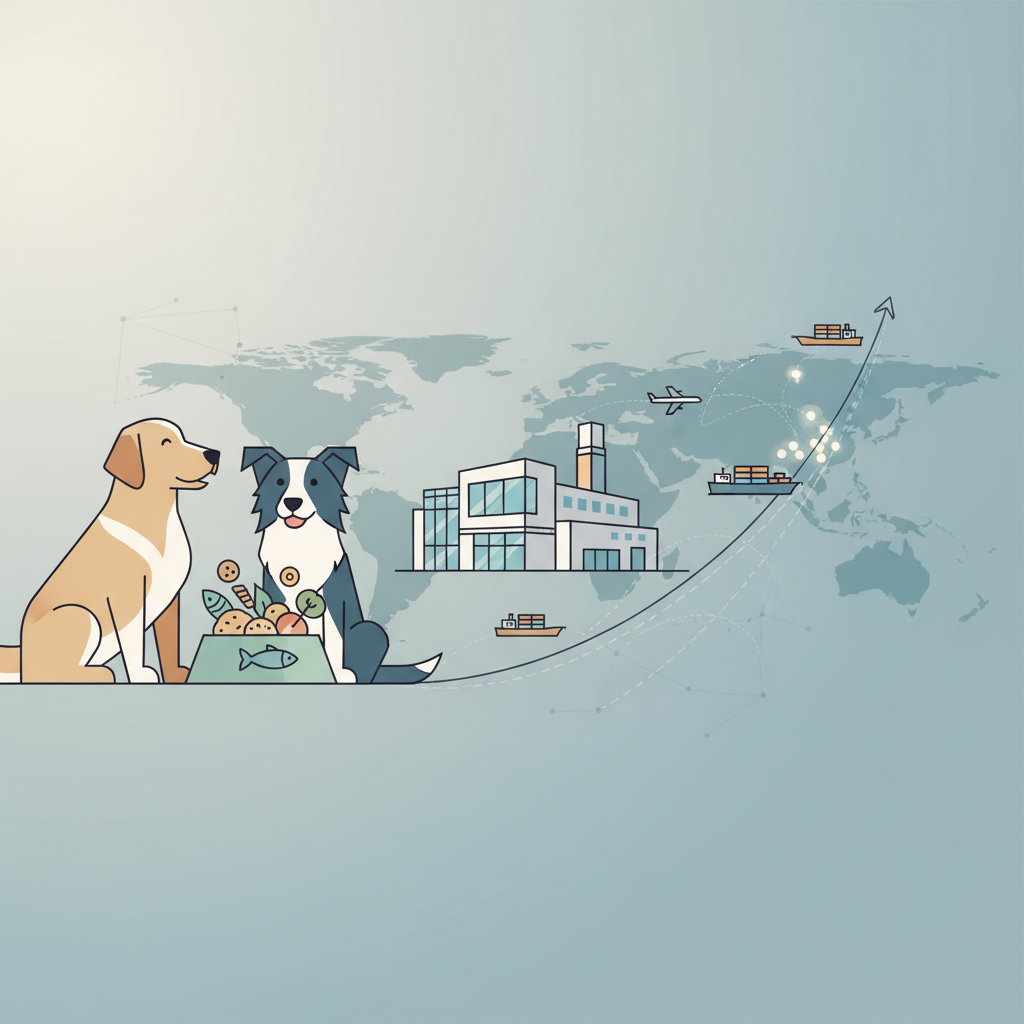

The global pet food market is experiencing unprecedented growth, with Southeast Asia emerging as a dynamic hub for this expansion. For B2B players—importers, distributors, wholesalers, and private label brand owners—understanding the complexities of the international dog food supply chain is not just an advantage, it’s a necessity. From navigating diverse regulatory landscapes to ensuring sustainable raw material sourcing and optimizing logistics, each step presents unique opportunities and challenges. This comprehensive guide aims to equip you with the insights and actionable strategies needed to thrive in this vibrant market, focusing on delivering practical value for your business operations. Whether you're looking to expand your import portfolio or launch your own private label brand, mastering the nuances of the global dog food trade in Southeast Asia will be key to your success.
The Evolving Landscape of Dog Food Imports in Southeast Asia
Southeast Asia, encompassing diverse economies like Thailand, Vietnam, Indonesia, Malaysia, and the Philippines, represents a lucrative yet complex market for dog food. Rising disposable incomes, increasing pet ownership, and a growing humanization of pets trend are fueling demand for high-quality, nutritious, and specialized dog food products.
Understanding Market Demand and Consumer Preferences
The preferences of dog owners across Southeast Asia are diverse, influenced by local culture, climate, and economic factors. While premium, grain-free, and natural formulations are gaining traction, affordability remains a significant driver in many segments.
- Key Trends: Look for increasing demand in functional foods (e.g., joint support, skin and coat health), breed-specific diets, and sustainable ingredient sourcing.
- Local Flavors and Ingredients: Opportunities exist for products incorporating locally recognized ingredients or flavors that resonate with regional consumers.
- Packaging Innovations: Convenience, sustainability, and clear nutritional information on packaging are highly valued.
- Actionable Insight: Conduct thorough market research tailored to specific countries within Southeast Asia. Partner with local distributors who possess deep market knowledge to identify underserved niches and emerging trends.
Regulatory Frameworks and Compliance
Each country in Southeast Asia has its own set of regulations governing the import, labeling, and sale of pet food. Navigating these can be daunting, but compliance is non-negotiable.
- Common Requirements: Expect requirements related to ingredient declarations, manufacturing process certifications (e.g., HACCP, GMP), health certificates from the country of origin, and specific labeling guidelines (e.g., language, nutrient guarantees).
- Pre-Market Approval: Some nations may require pre-market approval or registration of pet food products, which can be a time-consuming process.
- Prohibited Ingredients: Be aware of any ingredients that may be restricted or prohibited in certain countries.
- Actionable Insight: Engage with regulatory consultants or your logistics partners early in the process. Build strong relationships with customs brokers who specialize in pet food imports in your target markets. Develop a comprehensive compliance checklist for each country to ensure all legal requirements are met before shipment.
Sourcing Raw Materials: Quality, Traceability, and Sustainability
The quality of raw materials directly impacts the nutritional value, safety, and marketability of the final dog food product. For B2B stakeholders, securing a reliable and high-quality raw material supply chain is paramount.
Key Raw Material Considerations
From protein sources to grains and supplements, every ingredient plays a crucial role.
- Protein Sources: High-quality animal proteins are foundational. Consider diverse options like chicken, beef, lamb, and even novel proteins. For regions with strong agricultural ties, exploring options like buffalo meat can offer a sustainable and cost-effective protein source, particularly for export markets. The use of certain co-products, such as buffalo Omasum, can also be explored for specific nutritional profiles or as a sustainable ingredient for treats and chews, provided it meets all regulatory standards.
- Carbohydrates: Grains (e.g., rice, corn, barley) or grain-free alternatives (e.g., sweet potatoes, peas, lentils) offer energy.
- Fats: Essential for energy and coat health (e.g., chicken fat, fish oil).
- Vitamins and Minerals: Crucial for overall health, often supplied through premixes.
- Actionable Insight: Diversify your raw material suppliers to mitigate risks associated with single-source dependency. Always request and verify certificates of analysis (COA) for all incoming ingredients. Conduct regular audits of your suppliers' facilities to ensure adherence to quality and safety standards.
The Importance of a Robust Traceability System
Traceability is no longer a luxury; it's a necessity. Consumers and regulators alike demand transparency regarding the origin and journey of ingredients.
- Farm-to-Bowl Tracking: Implement systems that allow you to trace every ingredient from its origin (farm or primary processing plant) through manufacturing, distribution, and to the retail shelf.
- Recall Preparedness: A robust traceability system is vital for efficient and targeted product recalls, minimizing brand damage and ensuring consumer safety.
- Quality Assurance: It helps identify the root cause of quality issues, allowing for corrective actions and continuous improvement.
- Actionable Insight: Invest in supply chain management software that can track batch numbers, supplier information, and certifications. Partner with suppliers who are transparent about their sourcing practices and have their own robust traceability protocols in place.
Private Labeling Dog Food: Opportunities and Challenges
Private labeling offers a compelling pathway for importers, distributors, and entrepreneurs to establish their own brand presence in the dog food market without the substantial investment in manufacturing facilities.
Benefits of Private Labeling for Importers and Distributors
- Brand Ownership and Differentiation: Create a unique brand identity, control branding, and build customer loyalty.
- Higher Margins: Eliminate intermediary brand markups, leading to potentially higher profit margins.
- Market Responsiveness: Ability to quickly adapt product formulations and packaging to meet evolving market demands and trends.
- Exclusivity: Secure exclusive distribution rights for your private label brand within specific regions.
- Actionable Insight: Focus on creating a strong brand story and unique selling proposition (USP) for your private label product. This differentiation will be crucial in a competitive market.
Partnering with the Right Manufacturer: A Checklist
Choosing the right manufacturing partner is perhaps the most critical decision in private labeling.
- Experience and Reputation: Look for manufacturers with a proven track record in pet food production and experience with export regulations for your target markets (e.g., Southeast Asia).
- Certifications: Verify their certifications (e.g., ISO, GMP, HACCP, FDA registration if applicable), ensuring they meet international and local standards.
- Formulation Capabilities: Can they develop or customize formulations to meet your specific nutritional, ingredient, and price point requirements?
- Raw Material Sourcing: Inquire about their raw material sourcing policies, quality control, and traceability systems.
- Production Capacity and Flexibility: Ensure they can meet your volume requirements, both initial and projected growth, and offer flexibility for product variations.
- Quality Control Protocols: Understand their in-house testing procedures and third-party laboratory verification.
- Packaging Options: Do they offer a range of packaging types and sizes, and can they handle your specific branding requirements?
- Logistics Support: Do they offer support with export documentation, shipping, and customs clearance?
- Communication and Transparency: A strong, communicative relationship is vital for long-term success.
- Actionable Insight: Conduct on-site audits of potential manufacturing partners whenever possible. Request references and speak to their existing clients. Begin with a smaller pilot project to assess compatibility and performance before committing to a large-scale agreement.
Optimizing Your Dog Food Supply Chain for Efficiency
An efficient supply chain minimizes costs, reduces lead times, and ensures product freshness, all crucial factors for profitability and customer satisfaction.
Logistics and Shipping: Navigating International Waters
International shipping involves complex logistics, tariffs, and potential delays.
- Mode of Transport: Evaluate sea freight versus air freight based on cost, urgency, product shelf life, and volume. Sea freight is generally more cost-effective for bulk shipments.
- Incoterms: Clearly define Incoterms (International Commercial Terms) with your suppliers and buyers to establish responsibilities for costs, risks, and insurance.
- Documentation: Ensure all shipping documents (e.g., commercial invoice, packing list, bill of lading/airway bill, certificates of origin, health certificates) are accurate and complete to avoid customs delays.
- Customs Clearance: Work with experienced customs brokers in both the exporting and importing countries.
- Actionable Insight: Develop strong relationships with reliable freight forwarders who have expertise in food product logistics to Southeast Asia. Consider obtaining marine cargo insurance to protect against loss or damage during transit.
Inventory Management and Demand Forecasting
Effective inventory management prevents stockouts and reduces carrying costs, while accurate demand forecasting is its cornerstone.
- Just-In-Time (JIT) vs. Safety Stock: Balance the benefits of JIT (reduced holding costs) with the need for safety stock to buffer against supply chain disruptions or unexpected spikes in demand.
- Forecasting Tools: Utilize historical sales data, market trends, seasonality, and promotional activities to improve forecast accuracy.
- Warehouse and Distribution: Choose strategically located warehouses with appropriate storage conditions (e.g., temperature control) and efficient distribution networks within Southeast Asia.
- Actionable Insight: Implement an Enterprise Resource Planning (ERP) system or specialized inventory management software. Regularly review and adjust your forecasting models based on actual sales data and market feedback. Collaborate closely with your sales and marketing teams to anticipate future demand fluctuations.
Risk Mitigation in Global Pet Food Trade
The international trade of dog food is not without risks, from quality issues to geopolitical instability. Proactive risk management is essential.
Quality Control and Assurance
Maintaining consistent quality is paramount for brand reputation and consumer trust.
- Pre-Shipment Inspections: Arrange for independent third-party inspections of products before they leave the manufacturing facility.
- Post-Arrival Testing: Conduct random sampling and testing upon arrival at the destination port or warehouse.
- Supplier Audits: Regularly audit your raw material suppliers and manufacturing partners.
- Feedback Loops: Establish a robust system for collecting and acting on customer feedback regarding product quality.
- Actionable Insight: Develop a comprehensive Quality Assurance (QA) plan that covers every stage from raw material sourcing to final product delivery. Clearly define quality specifications with all your partners.
Geopolitical and Economic Factors
Global trade is susceptible to broader external influences.
- Trade Agreements and Tariffs: Stay informed about changes in international trade agreements, tariffs, and import duties that could impact costs or market access.
- Currency Fluctuations: Hedging strategies can mitigate risks associated with volatile exchange rates.
- Political Stability: Assess the political and economic stability of both sourcing and target markets.
- Actionable Insight: Diversify your sourcing and distribution channels where feasible. Stay updated on global economic news and geopolitical developments that could affect trade routes or supply chains.
Conclusion
The dog food market in Southeast Asia offers immense potential for B2B enterprises prepared to navigate its complexities with strategic foresight and operational excellence. By focusing on deep market understanding, robust raw material sourcing, diligent regulatory compliance, and efficient supply chain management, importers, distributors, and private label brand owners can unlock significant growth. Building strong partnerships, embracing transparency, and committing to quality will not only ensure compliance but also foster consumer trust and loyalty in this dynamic region. The journey may be intricate, but with the right approach, your business can successfully thrive in the global dog food trade.
Call to Action:
Ready to explore opportunities in the thriving Southeast Asian dog food market or optimize your existing supply chain? Connect with our team of experts today to discuss tailored solutions for your import, private labeling, or raw material sourcing needs. Let’s build your success together.


